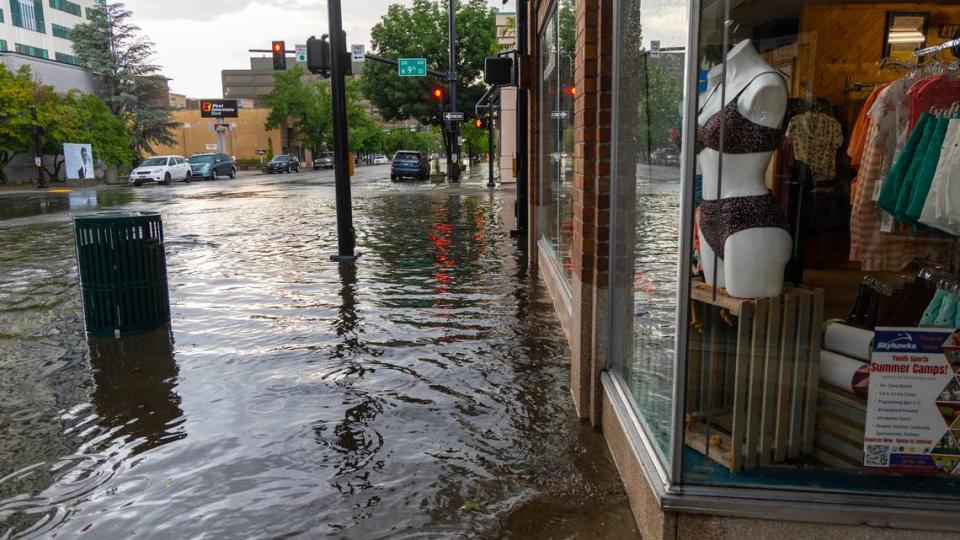Boise hit by thunderstorms with more on the way. Will there be more street flooding?
When a torrent of rain descended upon the Boise area on Tuesday, the streets were flooded with water. Cars navigated through puddles a foot deep in some places and a slew of highway district employees were up until 2:30 a.m. cleaning out drains.
The Idaho Statesman looked into why the city’s drainage system couldn’t handle the storm, a situation that also happened last week.
The localized storm dumped 1.47 inches of rain in some parts of downtown and 1.77 inches in the North End. It came close to the June 12, 1958, city record when 1.9 inches fell on Boise, according to the National Weather Service.
️ Rain totals in Boise this evening are on the order of 1 to 2 inches. Rain is on its way out tonight but the potential for more heavy rain returns tomorrow afternoon. Stay tuned. #IDwx pic.twitter.com/dw3YSkBRMC
— NWS Boise (@NWSBoise) June 7, 2023
So why would such heavy flooding happen in Boise during a downpour? Simply put, the types of street drains in Boise weren’t built to handle that much water, according to Lloyd Carnegie, maintenance manager for the Ada County Highway District.
The city has “100-year storm” drains. The 100-year storm is a “precipitation event with such intensity that there is only a 1% chance that a storm of such intensity will occur in any given year,” according to environmental engineering company Dudek.
“This storm is used as the design storm for many large regional facilities nationwide because it provides a sufficient level of safety against flooding — 99% of storms that occur each year for a particular duration will be less intense than the 100-year storm,” the Dudek website states.
Tuesday’s storm was more intense than the theoretical 100-year storm, according to Carnegie.
“It just overwhelmed our drainage system,” Carnegie told the Statesman by phone. “So it took a while for our system to be able to move that water to where it needed to go.”
It took five sewer-cleaning trucks, 10 drainage crew operators, 10 broom operators and six supervisors to deal with the aftermath.

The highway district could decide to implement a larger drainage system, but Carnegie said it wouldn’t be worth it because Boise so rarely sees that much rain. It’s just odd that it has happened a couple of times this spring.
“We could design storm systems to handle way more water like a … 500-year storm event,” Carnegie said. “But it wouldn’t be prudent with the infrequency that we have these kinds of storm events. It would cost a lot of money for a large drainage system that really wouldn’t be used.”
Alejandro Flores, a hydrology professor at Boise State University, said flash floods can cause property damage and even put people’s lives at risk. Some may not know how to drive through flooded streets or when to turn around. Flooded water can also become dangerous when it builds up behind objects.
“In the case of Fort Collins (Colorado) in 1997, water piled up behind a railway embankment, and at some point, that railway embankment either overturned or just kind of blew out,” Flores said. “It created a literal wall of water that inundated a trailer park behind it. It actually killed a couple of people.”

As the Treasure Valley continues to grow, Flores said he hopes local governments plan drainage systems effectively. He also warned that climate change could cause the area to see an increase in intense storms.
“When we get these kinds of storms, how does just the fact that we’ve converted a lot of farmland into subdivisions and urban areas — and even a sagebrush steppe — into suburban areas change the response of the land surface to precipitation events?” Flores said. “The No. 1 thing that I would be looking at is our infrastructure.”
The Treasure Valley has seen a number of severe thunderstorm warnings lately and more may be on the way. Tuesday night’s storms came just a week after similar small-cell thunderstorms rapidly dropped over an inch of rain and caused flooding in West Boise, the Idaho Statesman reported. The Weather Service is forecasting storms to continue barraging the city each night for at least another week.
ACHD spokesperson Rachel Bjornestad said residents can help by learning the locations of their neighborhood drains and working to keep them clear. A map of local drains can be found on the ACHD website.
Weird weather: Boise residents posted the strangest sights they saw during freak storm

 Yahoo Sports
Yahoo Sports 